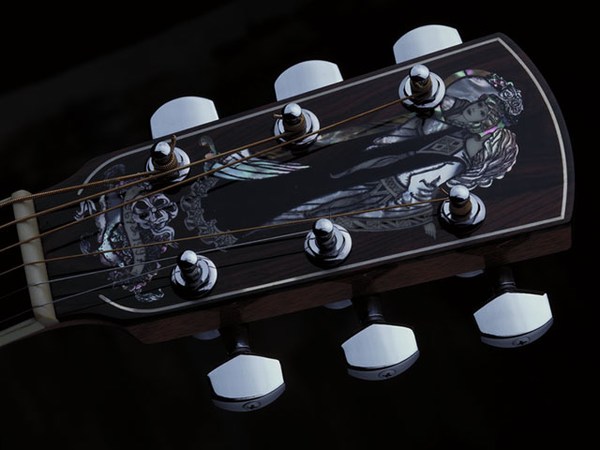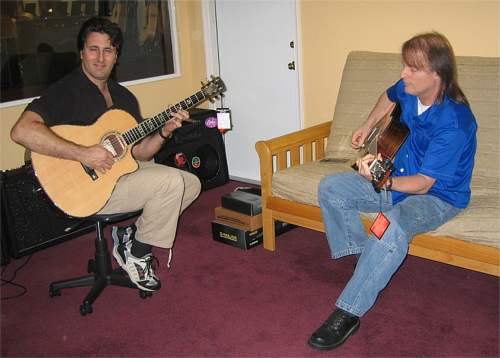|
|
Larrivee Guitars and Accessories Authorized Dealer
|
| |
|

Larrivee
Acoustic Guitars
|
|
 |
|
|
|
About
Larrivee Guitars
Coming Soon . . . |
|
Larrivee Features
Coming Soon . . . |
|
Larrivee
Guitars - Custom Options
Coming Soon . . . |
|
Larrivee
Guitars - Current Inventory
Coming Soon . . . |
|
Larrivee
Guitars - Current Inventory - Pre-Owned
Coming Soon . . . |
|
|
|

|
|
Friends in the
Amp Room! Good
Friends, Chip Mills (right) (Great Singer) and a true Virtuoso, hailing
from Spain, Antonio Bolet (left) checking out
Larrivee's LV-10-E with Custom Inlaid Headstock.
Great night, Late night, at least Chip got us some Pizza! |
Larrivee History
|
Jean Larrivée first
became interested in the guitar as a teenager, trying to play Duane Eddy
licks on an $18 guitar. At twenty, with no other musical training in his
background, he made the decision to take up a serious study of classic
guitar. Four years into this study, he was introduced to German
classical guitar builder Edgar Mönch, who was then working in Toronto.
Jean expressed interest in learning how to build, Mönch invited him to
visit his shop, and so began an apprenticeship.
Jean built his first two guitars under Mönch's tutelage before setting
up a workshop in his home, where he continued to build and study. The
energy which had fueled nightly five hour practice sessions was now
directed toward learning to construct instruments. He had found his
life's work.
From 1968 to 1970, Jean continued building classic guitars in his home
shop before moving into his first commercial space, the second floor of
a theater. His work brought him into contact with many people involved
with Toronto's thriving folk music community. At their urging, Jean
built his first steel string guitar in 1971.
This was a period of much experimentation. Following the tradition of
European classic guitar builders, Jean designed his own distinctive
shape, bracing patterns, and structural specifications. When he began to
build steel string instruments, a task for which there were fewer
well-established models, the experimentation became especially intense.
His first steel strings were small dreadnoughts, braced in the Martin
style, with an elongated X (the "railway crossing sign" design) and tone
bars running at about a 45† angle. Sensing from his work with classic
guitars that a symmetrical bracing pattern might result in better tonal
balance, Jean tried a bracing pattern consisting of a true 90† X brace
and tone bars running parallel to the bridge. The guitar had a strong,
well-balanced sound. It was, as Jean says now, "success through
ignorance." Twenty-five years later, a much-refined version of this
bracing pattern is still the heart of all Larrivée steel-string guitars.
The sound it produces is distinctive. The bass is solid and tight, with
great projection. Mid-range is strong, and highs are crystal clear.
Overall balance is excellent, with the body size and shape determining
the "tilt" of the balance.
Best of all, twenty-five years and over twenty thousand steel string
guitars have proven conclusively that this design has great structural
integrity. Bulging of the top behind the bridge or sinking around the
sound hole are not uncommon problems with traditionally braced guitars,
particularly those with scalloped braces. With Larrivée symmetrical
bracing, these types of problems are virtually non-existent.
From 1971 to 1977, Larrivée Guitars grew steadily, moving four times to
ever larger spaces. There was a continuous flow of apprentices through
the shop, some of whom would also go on to become successful builders on
their own. In 1972 Jean and Wendy Jones were married. Wendy would make
her own unique contribution, designing and engraving the exquisite
picture inlays for which Larrivée guitars are famous.
By 1976 eight people were producing twenty-five to thirty instruments a
month. Most of these instruments were sold in Canada or exported to
Europe, where their classically inspired look won quick acceptance. The
American market would prove to be a tougher nut to crack. Larrivée
guitars, with their wood binding, marquetry rosettes, clear pickguards,
and Renaissance-style inlay designs, were a bit out of step with
American fashion. Still, there were some bright spots. Several
high-profile artists purchased guitars and word began to get around.
More than a few American musicians made the trip to Toronto in search of
a Larrivée guitar, and some American dealers began stocking them.
In 1977, Jean and Wendy pulled up stakes and moved the company to
Victoria, British Columbia. The wet coastal forests of Canada's Pacific
Rim produce some of the finest spruce and cedar in the world, and Jean
realized that future growth could hinge on access to these tone woods.
Of course, there was also the allure of Canada's mildest climate and the
spectacular scenery of British Columbia.
In Victoria, Jean began to concentrate on the problems of manufacturing
instruments in larger quantities. Setting up shop for the first time in
space that was purchased rather than rented made it practical to install
a climate controlled construction room and an industrial paint booth.
Jean designed and built specialized machines and tooling which made it
possible to build more guitars, and to achieve a higher level of
precision at the same time. Within a year of the move, fourteen people
were producing four guitars a day.
While the company continued to grow and prosper in Victoria, eventually
the problems inherent in being on an island became too much. In 1982, a
decision was made to relocate to the mainland. It was the era of
electronic keyboards and day-glow electric guitars, and a tough time for
nearly all acoustic guitar builders. Rather than cut back on production
and lay off employees, Jean decided to take the "if you can't beat 'em,
join 'em" route. In 1983, he began to build solid body electrics.
By 1989, the market for acoustic guitars had begun to improve. Jean once
again turned his full attention to his first love. The knowledge gained
from electric guitars proved invaluable as Jean reinvented his acoustic
guitar production techniques. New tooling was built. Computer-controlled
milling machines were brought into the process. New models were added.
In 1991, when the Acoustic market had made a full come back, Larrivée
moved to a bigger building. At first it seemed a little difficult to
fill 11000 square feet. (At the time only 25 guitars a day were being
made by 35 people) However, it soon became apparent that that 11000
square feet wasn't enough...
An the beginning of 1997, Larrivée introduced a model called the D-03.
It was originally intended to be a limited run of 1000 but, as soon as
people caught on to the fact that it was the only all solid wood guitar
for under $800, the demand increased and it became a standard model.
In early March 1998, Larrivée Guitars moved to a new 33000 square foot
facility in the heart of Vancouver, where 100 highly skilled people in
the Guitar industry made 60-72 guitars a day. Much of this production
was to accommodate our largest client at the time. On September 1st 2001
Larrivee expanded again, and opened the door on it's new factory in
southern California. Ten days later the events of 9/11 occurred. As you
can imagine this was not a time for companies to be expanding. The
following two years were quite turbulent for the guitar industry as a
whole. People where not spending money on acoustic guitars. Almost every
major manufacturer was having layoffs - Including ourselves. Production
dropped to 35 guitars a day. Over the next two years, Larrivee would go
through of number of production changes including: a refocus towards
high-end guitar, A redesign of the -03 Series, and the development of
the Traditional Series.
Today Jean, his wife Wendy, his son Matthew and daughter Christine all
work in the California plant producing the gloss finish guitars. Jean's
other son John Jr runs the Canadian plant which produces our satin
models.
Since the move, our company has continued to grow. Reflecting this
growth, and our continued deployment of leading-edge production tools,
we also acquired two new Fadal CNC machines in spring, bringing our
total CNC complement up to 8, as well as a Laser cutter. These additions
to our factory have allowed us to achieve even higher levels of
efficiency and quality control which benefit buyers and players of
Larrivée guitars.”
|

|
|